The iconic Galle Face Green once covered a massive area, even larger than what it is now, with one end bounded by the Beira Lake and the other lying on the boundary of the Galle Face Hotel. This incredible greatness has been shrunk to a still-respectable five hectares of parkland bounded by the Indian Ocean at present, but it is by no means small in the hearts of the locals living in the territory. Indeed to most, it is the place to go to during the kite-flying season when high winds blow in from the sea, whipping over the western part of the island to hold their lightweight aerial constructs aloft.
Galle Face Green is among the best places to visit in Colombo if one wants some salty sea air.
The place actually has a history dating back to the British period and the end of the Dutch era and there are plenty of legends surrounding the etymology of Galle Face Green. There is one theory that tells us about the Dutch origins of the grounds, about the name of the original fortifications in the area being called the “Gal” gate, or “Gal Faas”, facing the southern regions of Galle. One goes as far as suggesting that there is some Sinhala mixed into its name. This is when you take the local word for stone, “Gal” into consideration. “Gal Gate” refers to the rocky gateway of the fortifications bordering the Green, or which used to border it. While it was used for equestrian events and as a cricket and polo ground by the British, it was first laid out by the Dutch in order to launch attacks to repulse Portuguese attacks with their artillery. Yet as for its modern purposes as a recreational space, it was Governor Sir Edward Barnes who first introduced horse racing to the park in 1820.
The original racecourse was about one and a half miles long around and was referred to as the Colpetty Race Course. It was the official venue of interest for equestrian enthusiasts until 1893 when the races were moved to the present location of the Colombo Racecourse. 1879 was the era of many more major sporting events, including the introduction of golf and rugby. The Colombo Club in the vicinity was used as an official governing center of the gentlemen’s sporting events. In the same year, the British expatriates and aristocrats saw the inauguration of the Colombo Golf Club. As for other historic events, the very first Royal-Thomian cricket match was played at Galle Face Green in 1879, from the fifteenth to the seventeenth of March. Royal College-then called Colombo Academy-won by 56 runs. Presently some of the other hotels and tourist spots facing the Galle Face Green are the Kingsbury Hotel and the much simpler Galle Face Hotel.
Written by Vasika Udurawane for Travel Lanka Compass



0 Comment